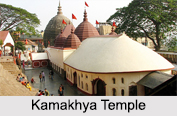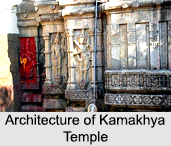 Kamakhya Temple is considered as most holy and oldest of the 51 Shakti Peethas on earth. It is a famous pilgrimage located at Guwahati, Assam. It is located on Nilachal Hills in western part of Guwahati, Brahmaputra River. Kamakhya Temple is a part of the four most important Shakti Peethas along with the Vimala Temple and Sthana Khanda in Odisha and Dakhina Kalika in Kolkata, West Bengal.
Kamakhya Temple is considered as most holy and oldest of the 51 Shakti Peethas on earth. It is a famous pilgrimage located at Guwahati, Assam. It is located on Nilachal Hills in western part of Guwahati, Brahmaputra River. Kamakhya Temple is a part of the four most important Shakti Peethas along with the Vimala Temple and Sthana Khanda in Odisha and Dakhina Kalika in Kolkata, West Bengal.
Myths of Kamakhya Temple
The accurate date of the original temple is not known. It is believed that, the temple is an ancient one. It was rebuilt in 1665, after being destroyed by Muslim invaders. Sacrifices are still very much part of worship here. There is a legend attached to the history of the temple, which goes way back to the mythological age. According to the legend, "Sati" the wife of Lord Shiva took her life at a `Yagna` ceremony that had been organized by her father Daksha, as she could not bear the insults hurled at her husband by her father. On hearing the news of his wife`s death, Shiva, the destroyer of all evil flew into a rage and punished Daksha by replacing his head with that of a goat. Torn between misery and blind fury, Shiva picked up the corpse of his beloved wife Sati and performed a dance of destruction called the `Tandava`.
The intensity of the destroyer`s fury was so devastating that it took several Gods to pacify his anger. In the midst of this struggle, Sati`s dead body accidentally got cut into 51 parts by the disc in the hands of Lord Vishnu and her female genitalia or `Yoni` fell on the spot where the Kamakhya temple stands today, forming one of the many Shakti Peethas adorning the rest of her body parts. The place where her uterus fell was not known till the God of love, Kamadeva, searched it out to rid himself of a certain curse of Brahma. Kama regains his body here. The place came to be known as `Kamarup` and the presiding deity as `Kamakhya` or one worshipped by Kama.
Another legend says that the demon Narakasura fell in love with Goddess Kamakhya once and wanted to marry her. As a goddess, she could not marry a demon, Goddess Kamakhya played a trick to save herself and laid a condition that she would marry him only if he builds a temple for her within one night. Narakasura agreed to it and almost finished building the temple overnight. This scared Goddess Kamakhya and before the final steps of the temple were completed, a cock was sent to cry cock-a-doodle-do to announce the arrival of the morning, before it was actually dawn. This made Narakasura very angry and he killed the cock on that spot. According to the condition Narakasura couldn`t marry Goddess Kamakhya after that. It is said that the present Kamakhya temple is the same that Narakasura had made for the Goddess.
Another legend says that Shakti, the mother Goddess, challenged the supreme creative power of Brahma and that could thereafter create, only with the blessings of the "Yoni", as the sole creative principle. After much penance, Brahma brought down a luminous body of light from heaven and placed it within the "Yoni" circle, which was created by the Goddess and placed at Kamarupa Kamakhya in Guwahati.
Architecture of Kamakhya Temple
King Nara Narayana of Cooch Behar rebuilt the temple in 1665 after it had suffered the destruction of foreign invaders. The temple consists of seven oval spires, each topped by three golden pitchers, and the entrance spirals down to a curvy path of a little distance, which specially links the main road to the temple. Some of the sculptured panels of the temple carry the depictions of Gods and Goddesses of Hindu pantheon carved in a delightful pattern. Tortoises, monkeys, and large number of pigeons can be found here. The cryptic, as well as the peaceful ambience of the temple combine together to soothe the nerves of visitors, and take their minds to flights of inner salvation, and this is the very reason that people come here for. Images of Gods and Goddesses of Hindu religion are carved on the walls. The image of the Goddess along with other deities is kept on a throne.
The current temple structure was constructed in 1565 by Chilarai of the Koch dynasty in the style of medieval temples. The temple consists of three major chambers. The western chamber is large and rectangular and is not used by the general pilgrims for worship. The middle chamber is a square, with a small idol of the Goddess. The walls of this chamber contain sculpted images of Naranarayana, related inscriptions and other Gods. The middle chamber leads to the Sanctum sanctorum of the temple in the form of a cave, which consists of no image but a natural underground spring. The spring emanates from a fissure in a large rock that symbolizes a "Yoni". In summertime, the water runs red with iron oxide resembling menstrual fluid, an occasion for the "Ambubachi" festival. Though the temple is aligned facing east like most Hindu temples, the worship of the "yoni" is performed facing north.
The Kamakhya Temple has a beehive like "shikhara". Some of the sculptured section seen here are of interest. There are images of Ganesha, Chamundeswari, dancing features etc. The temple is a natural cave with a spring. Down a flight of steps to the bowel of earth, is located a dark, mysterious chamber. Here, draped with a silk sari and covered with flowers, is kept the "matra yoni". There is no image of Shakti here. Within a corner of a cave in the temple, there is a sculptured image of the "Yoni" of the Goddess, which is the object of reverence. A natural spring keeps the stone moist. Among the other temples on the Neelachala hill include those of Tara, Bhairavi, Bhuvaneswari and Ghantakarna with all its enigmatic splendour and picturesque locale, the Kamakhya Temple is one of the most astounding structures, not only in Assam, but also in the whole of India.
Festivals of Kamakhya Temple
The annual festival is known as the "Ambubachi Mela". Another yearly celebration is the "Manasa Puja". Durga Puja is also celebrated yearly at Kamakhya during Navaratri in the autumn. This five-day festival attracts a number of visitors.
Visiting Information of Kamakhya Temple
Buses and Auto - rickshaws are regularly connecting it to the various parts of Guwahati. Auto-rickshaw/ trekker/ taxi is available from Guwahati Railway Station, which is 6 kilometres from any other part of the city. Regular Buses of Assam Tourism Department also ply to and from Kamakhya Temple connecting it to parts of Guwahati. Guwahati Airport is located around 20 kilometres away. Regular flights connect it to other cities of India.





















